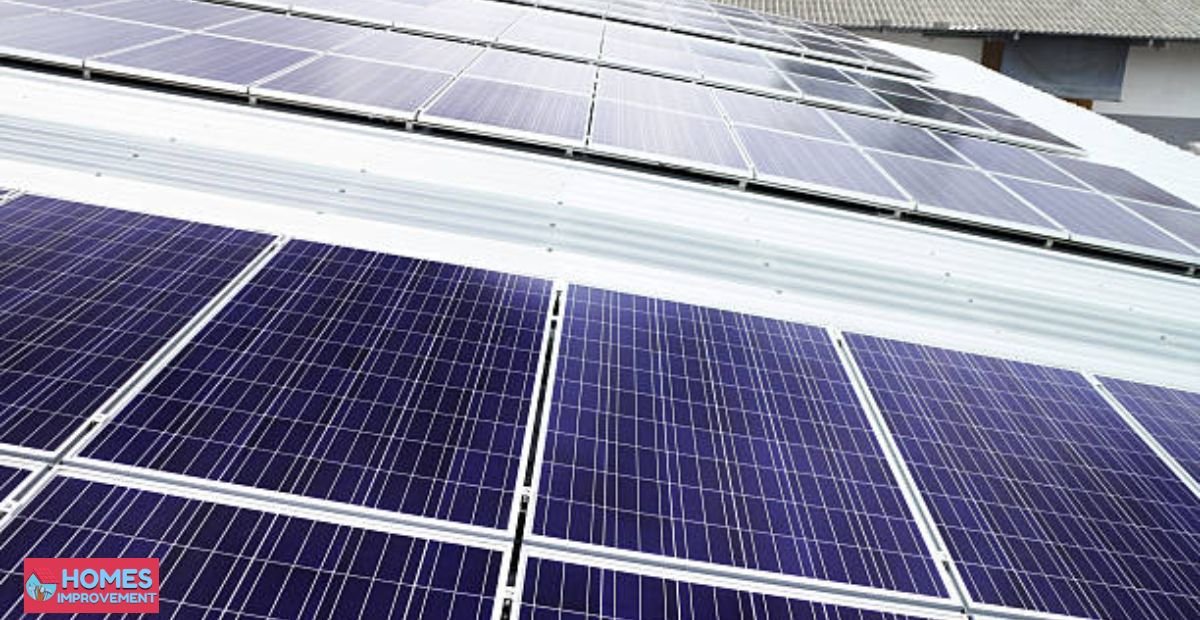Solar Panel Kit Installation for Home Improvement – Step-by-Step Guide

With rising electricity costs and a growing push toward sustainable living, more homeowners are turning to solar energy as a smart and practical upgrade. Installing a solar panel kit is one of the most effective ways to reduce your monthly utility bills while also increasing your home’s value. These kits are designed for easy installation and include all the essential components—solar panels, an inverter, mounting equipment, and wiring—making them ideal for DIY enthusiasts or those looking to cut down on professional installation costs.
Whether you’re planning to fully power your home or simply offset your current electricity usage, a solar panel kit can help you achieve energy independence. This step-by-step guide walks you through everything from understanding your energy needs to maintaining the system for long-term performance. With proper planning and execution, you can turn your rooftop into a powerful energy source and make your home more eco-friendly and future-ready.
Why Install a Solar Panel Kit at Home?
Homeowners today are increasingly turning to renewable energy to cut utility bills and boost property value. Installing a solar panel kit is a practical solution that supports both goals. These kits are now more accessible than ever, designed to simplify solar adoption even for beginners. Whether you’re planning a DIY project or hiring an expert, a kit provides all essential components: solar panels, inverter, mounts, and cables. What makes it even better? You don’t need to be a tech expert. With the right approach, you can power your home sustainably while reducing carbon footprints. Let’s dive into a clear, step-by-step process to guide your solar journey.
Step-by-Step: Installing a Solar Panel Kit the Right Way
Installing a solar panel kit might sound technical, but once broken into clear steps, it becomes a rewarding and manageable home improvement task. With a bit of preparation and attention to safety, you can cut down on energy bills while increasing your home’s value. This guide simplifies each phase of the process—from estimating your energy needs to powering up the system. Whether you’re a confident DIYer or someone hiring a professional, understanding the flow helps you oversee the job efficiently. Let’s go through each step one by one to ensure your solar journey starts right.
Step 1: Calculate Your Energy Needs
The first step is understanding how much electricity your household uses every month. Review your utility bills to find your average monthly energy consumption, measured in kilowatt-hours (kWh). Multiply that number by 12 for an annual estimate. This information helps determine what size solar panel kit will best suit your home. Undersizing the kit can leave you relying on the grid, while oversizing it can waste money. Accurate planning ensures your solar system generates enough power to meet daily requirements and provide long-term value.
Step 2: Inspect and Measure Your Roof
Your roof plays a critical role in how effectively your solar panel kit performs. Make sure the surface is free from shade caused by trees, chimneys, or nearby buildings. Ideally, your roof should face south (in the Northern Hemisphere) to maximize sun exposure. Measure the area to confirm it can accommodate the number of panels you’ll install. Also, evaluate the roof’s age and strength—older roofs may need repairs before installation. A well-placed, sturdy, and sunlit roof will significantly improve your solar system’s overall efficiency.
Step 3: Choose the Right Solar Panel Kit
Selecting the right solar panel kit is key to meeting your household’s energy goals. Kits vary in size, power output, efficiency, and included components. Look for monocrystalline panels if you want better efficiency in limited space. Check whether the kit includes a quality inverter, mounting hardware, and basic wiring. Some kits also come with battery storage, useful for blackout protection. Make sure the system complies with your local utility grid’s interconnection policies. Doing a little research upfront can save you headaches later and ensure you invest in a reliable solar setup.
Step 4: Install the Mounting Hardware
Once you’ve selected your kit and prepared your roof, it’s time to install the mounting hardware. This hardware secures the solar panels and keeps them stable in all weather conditions. Begin by marking the layout for the rails or brackets, ensuring proper spacing and alignment. Secure them to the roof rafters using lag bolts and flashing to prevent leaks. Double-check with a level to maintain a clean, even look. This step is crucial because even a small misalignment can impact how well your solar panel kit captures sunlight.
Step 5: Mount the Solar Panels
Now it’s time to place the panels on the mounting system. Carefully lift each solar panel and attach it to the rails using the provided clamps or fasteners. Make sure each panel is tilted at the optimal angle—typically between 25° and 45°, depending on your location—to capture the most sunlight. Tighten all bolts and screws to prevent movement during high winds or storms. Route the panel cables toward the inverter connection point. Once mounted securely, your panels will be ready to start absorbing solar energy for home use.
Step 6: Connect the Inverter and Wiring
The inverter is the heart of your solar panel kit, converting the DC electricity from your panels into AC power for your home. Install the inverter close to your main breaker panel or near the battery system if you’re using storage. Connect the wiring from the panels to the inverter using appropriately rated cables, connectors, and safety devices like fuses or breakers. Then, connect the inverter output to your home’s power supply. Don’t forget to ground the system properly. If you’re grid-tied, this stage may require inspection or approval before switching it on.
Step 7: Final Inspection and System Activation
After setup, your local building or utility authority may require a final inspection. This ensures your system meets all safety and electrical codes. Once approved, you can activate your solar panel kit and begin generating clean, renewable energy. Most kits include monitoring tools—either displays or mobile apps—to track power production in real time. Watch your system closely for the first few days to ensure everything is functioning smoothly. Congratulations! You’ve just taken a big step toward energy independence and a lower carbon footprint.
Benefits of Installing a Solar Panel Kit at Home
Installing a solar panel kit offers more than just energy savings—it’s a long-term investment in your home’s efficiency and value. With growing concerns about rising electricity costs and environmental impact, solar panels present a sustainable solution that delivers real-world benefits. These kits are easy to integrate into home improvement projects and can significantly reduce your reliance on grid electricity. Additionally, homeowners can enjoy government incentives, energy independence, and increased market appeal. Whether you’re looking to lower your bills or boost your home’s resale value, switching to solar is a smart move for both your wallet and the planet.
Key Benefits:
- Lower Electricity Bills: Reduce or eliminate monthly power costs by generating your own clean energy.
- Boost in Property Value: Homes with solar systems often sell faster and at higher prices.
- Environmentally Friendly: A solar panel kit reduces carbon emissions and supports green living.
- Energy Independence: Avoid rising utility rates and enjoy greater control over your energy use.
- Low Maintenance: Solar kits require minimal upkeep and can last 25–30 years or more.
- Government Incentives: Tax credits and rebates make solar installation more affordable.
- Silent and Efficient Operation: Panels work without noise, blending smoothly into your lifestyle.
- Net Metering Opportunities: Sell excess power back to the grid and earn credits on your bill.
Solar Panel Kit Cost Breakdown: What Should You Expect?
The total cost of a solar panel kit installation can vary based on several factors, such as the size of the system, your location, labor rates, and whether you choose a DIY or professional installation. On average, homeowners can expect to spend anywhere from $5,000 to $15,000 for a complete residential setup. While the initial investment might seem high, it’s important to consider the long-term savings and available tax incentives that can significantly reduce your out-of-pocket expenses. If you’re planning a DIY installation, you can save considerably on labor costs—but make sure you’re confident handling electrical components. Battery storage, permits, and additional hardware may also impact your final budget.
Estimated Solar Panel Kit Cost Breakdown
| Component / Service | Estimated Cost (USD) | Details |
| Solar Panel Kit (3kW–6kW) | $4,500 – $9,000 | Includes panels, inverter, mounts, and wiring |
| Battery Storage (Optional) | $2,000 – $7,000 | For backup during outages or off-grid living |
| Professional Installation | $2,000 – $5,000 | Labor, wiring, permits, and inspections |
| Permits and Inspection Fees | $300 – $800 | Varies by location and project size |
| Net Metering Setup (if needed) | $200 – $500 | For connecting your system to the utility grid |
| Monitoring System (Optional) | $100 – $500 | App or device to track solar performance |
| Maintenance (Annual Average) | $100 – $200 | Occasional cleaning or inspection |
Tip: Be sure to check with your local government or energy provider for rebates, solar incentives, or tax credits—they can save you thousands upfront.
Would you like a downloadable Excel or Word version of this table for client presentations or blog publishing?
Solar Panel Kit Maintenance Tips for Long-Term Performance
One of the best things about a solar panel kit is its low maintenance. Still, a little care goes a long way. Clean the panels every few months to remove dust, bird droppings, or leaves that may block sunlight. Use a soft brush, mild soap, and water. Avoid abrasive tools or harsh chemicals. Also, inspect the inverter regularly—many offer digital displays or mobile apps that report system performance. Watch for warnings or drops in energy output. Check wiring and mounting structures annually to ensure there’s no damage or corrosion. With regular upkeep, your solar kit can last 25–30 years efficiently and safely.
Mistakes to Avoid When Installing a Solar Panel Kit
While installing a solar panel kit can be a rewarding home improvement project, certain mistakes can cost you time, money, and system efficiency. Many homeowners, especially first-time installers, overlook critical details such as accurate system sizing or proper roof inspection. Others may skip important safety protocols or fail to comply with local codes. These missteps may seem minor at first but can lead to poor performance, expensive repairs, or even legal issues later on. By understanding and avoiding these common errors, you’ll ensure a safer, smoother, and more efficient solar setup for your home.
Common Mistakes to Avoid:
- Underestimating Energy Needs: Installing a system that’s too small won’t cover your electricity usage, leading to lower savings.
- Poor Panel Placement: Shaded or incorrectly angled panels reduce your system’s output significantly.
- Skipping Roof Inspection: Installing on a weak or damaged roof can cause leaks and structural damage over time.
- Ignoring Local Permits: Failing to get required approvals can result in fines or forced removal of your setup.
- DIY Electrical Work Without Experience: Improper wiring can cause fire hazards or inverter failure—always consult an electrician.
- No Monitoring System: Without monitoring, you might miss performance issues that affect long-term efficiency.
- Neglecting Maintenance: Even though solar systems are low-maintenance, ignoring basic care like cleaning or checks can lower output.
How to Maximize Your Solar Panel Kit Investment
To get the most from your solar panel kit, combine installation with smart home energy practices. First, shift high-usage activities—like running laundry or dishwashers—to sunny hours when panels are active. Second, use energy-efficient appliances to reduce consumption further. Third, track system performance through apps or inverters to identify any inefficiencies. If your utility offers net metering, feed extra energy back into the grid for credits. Also, consider expanding your system later with additional panels or battery storage. The more aware and proactive you are, the quicker you’ll achieve payback and long-term savings from your home solar investment.
Conclusion
A solar panel kit isn’t just an energy solution—it’s a lifestyle upgrade. It reduces your carbon footprint, cuts electricity bills, and enhances your home’s value. By following the proper steps—from calculating energy use to cleaning the panels—you’ll set yourself up for long-term success. With government incentives and rising utility rates, there’s no better time to invest. Just remember to avoid common pitfalls and keep your system maintained. Whether you install it yourself or hire help, solar power brings both peace of mind and future-ready living. Embrace the sun and make clean energy a central part of your home improvement journey.
FAQs
What’s the average payback period for a solar panel kit?
Most homeowners recover their investment in 5 to 8 years through energy bill savings and government incentives.
Can a solar panel kit work in cloudy or cold climates?
Yes, panels still generate power in cloudy weather and cold temperatures, though with slightly lower efficiency.
Do I need a permit to install a solar panel kit?
Yes, most local authorities require permits, especially if you’re connecting to the utility grid. Always check local codes.
How often should I clean my solar panels?
Clean panels every 3 to 6 months. If you live in a dusty or high-pollen area, more frequent cleaning may be needed.
Is battery storage necessary with a solar panel kit?
Not always. If you want backup power during outages or off-grid living, a battery is helpful—but not mandatory.





